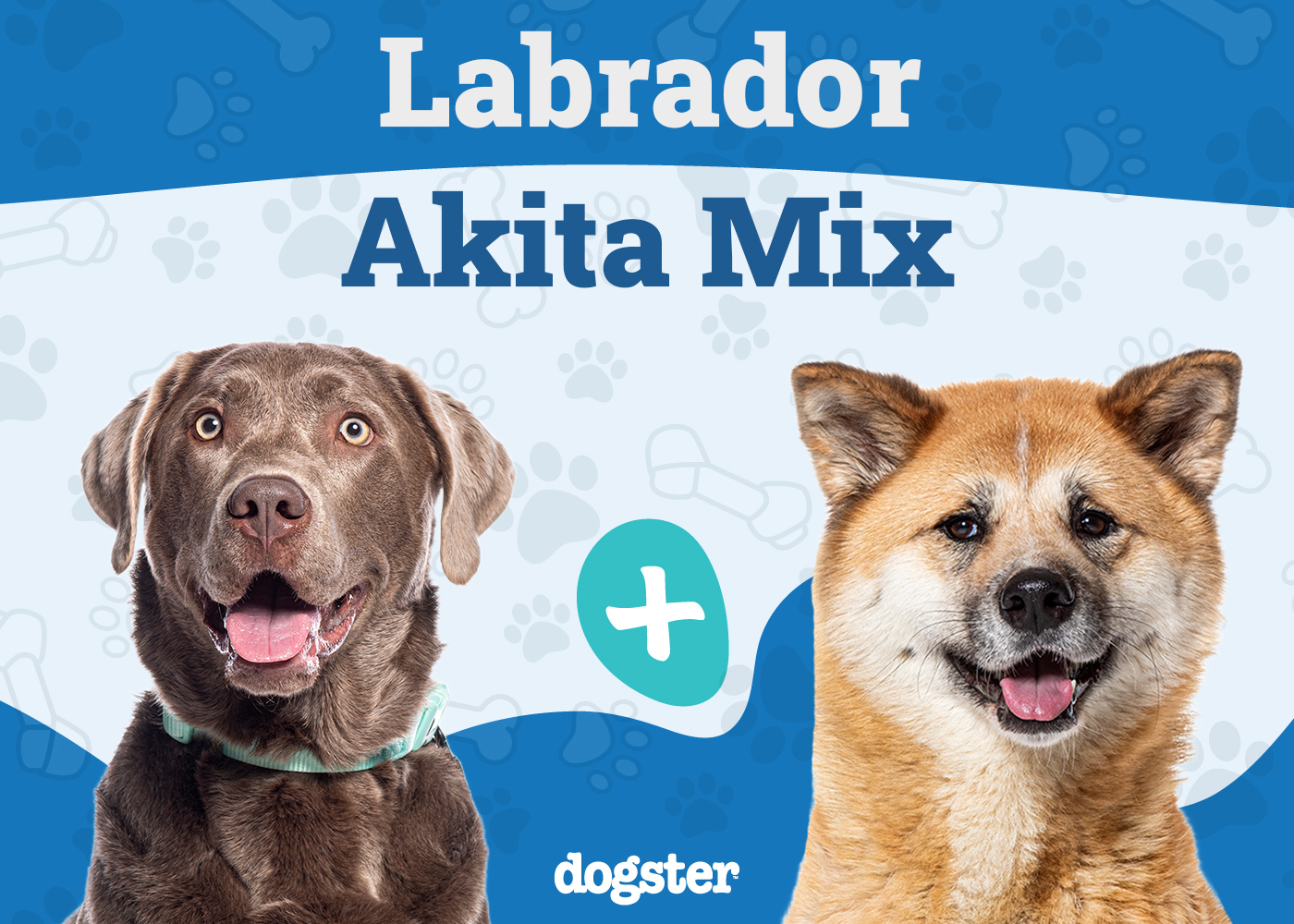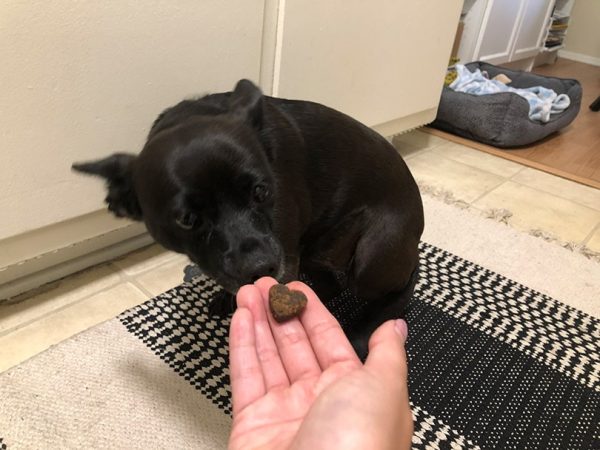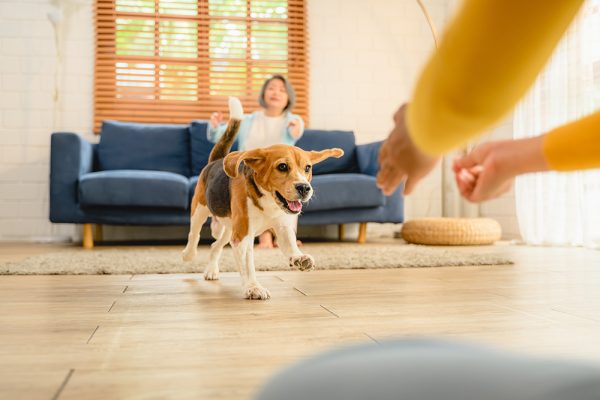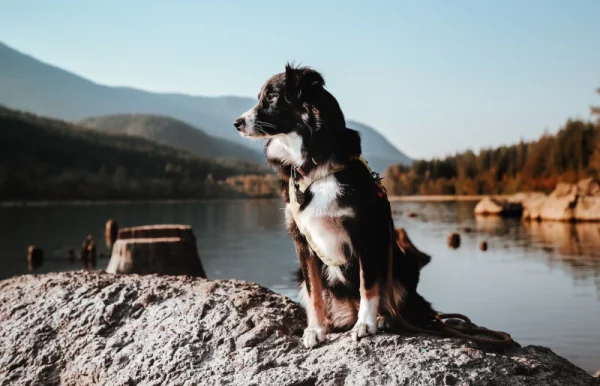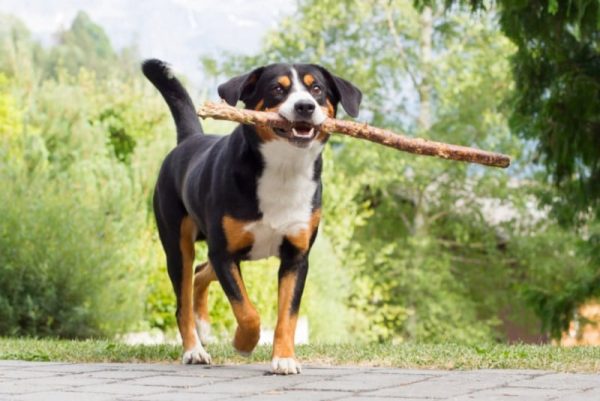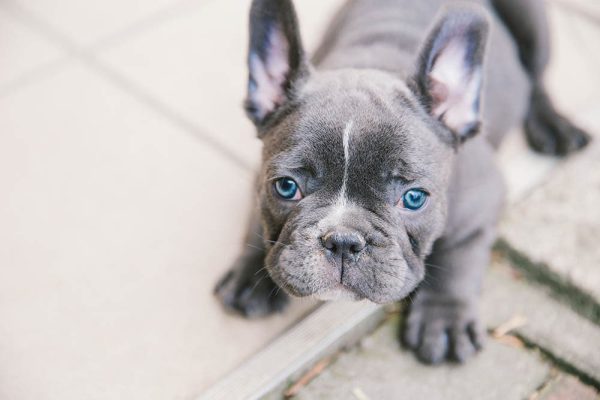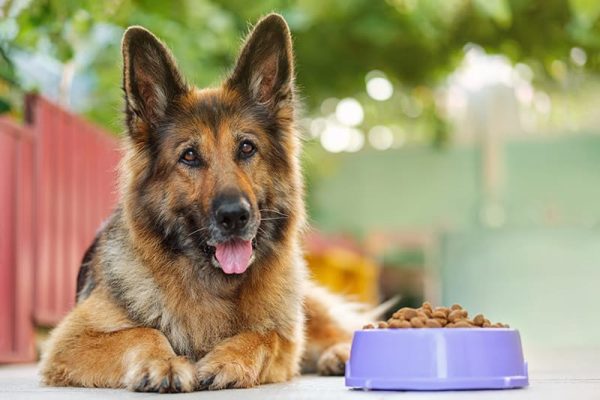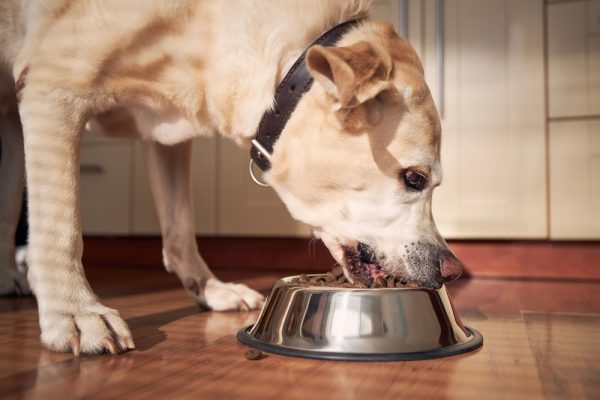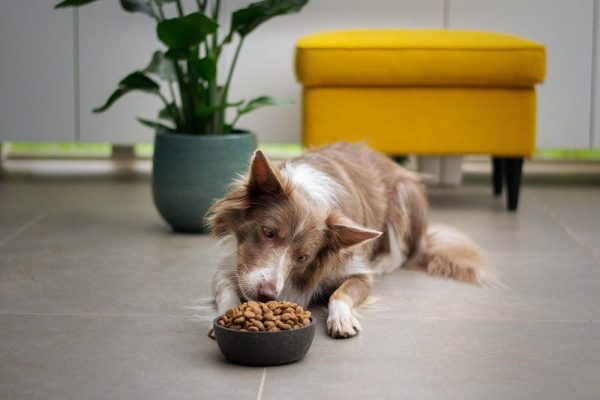In this article
View 8 More +Breed Overview
Height:
22–27 inches
Weight:
55–130 pounds
Lifespan:
10–14 years
Colors:
White, black, gray, brown, fawn, red, brindle, cream, mixed
Suitable for:
Families with adult kids, seniors, single owners, large properties
Temperament:
Protective, devoted, affectionate, sweet-tempered, restless, wary of strangers
Labrakitas are big, strong, fearless, and have a sweet temper, despite being aloof from strangers. The Labrador and Akita crossbreed is also incredibly loyal and eager to please its favorite humans. With the right training, it will quickly turn into your family’s favorite fur bud. But can you make a Labrakita friendly toward other pets? Are these dogs safe around children? How do you feed and groom them? Read on to find out!
Labrakita Characteristics

Labrakita Puppies
Labrador Retrievers are a go-to choice for a huge number of dog fans. Back in 2012, they were the fourth-most popular breed in the US. In contrast, Akitas only landed on the 55th spot on that same list. So, what about Labrakitas: will you have a hard time finding a doggo at a local shelter or breeder? Well, it depends on your area, but it might take some effort before you come across a pup to adopt. That’s mostly because this is a relatively new crossbreed.
A quick note: Labrakita puppies are incredibly energetic, inquisitive, and adventurous. Make sure you’re ready to handle an overzealous pet like that when you bring it home! Speaking of that, take a moment to puppy-proof the house and make it safe for the new (and furry) family member. Also, to guide all that raw energy in the right direction, start obedience training as soon as possible. The older the Labrakita, the harder it will be to tame its somewhat rebellious personality.
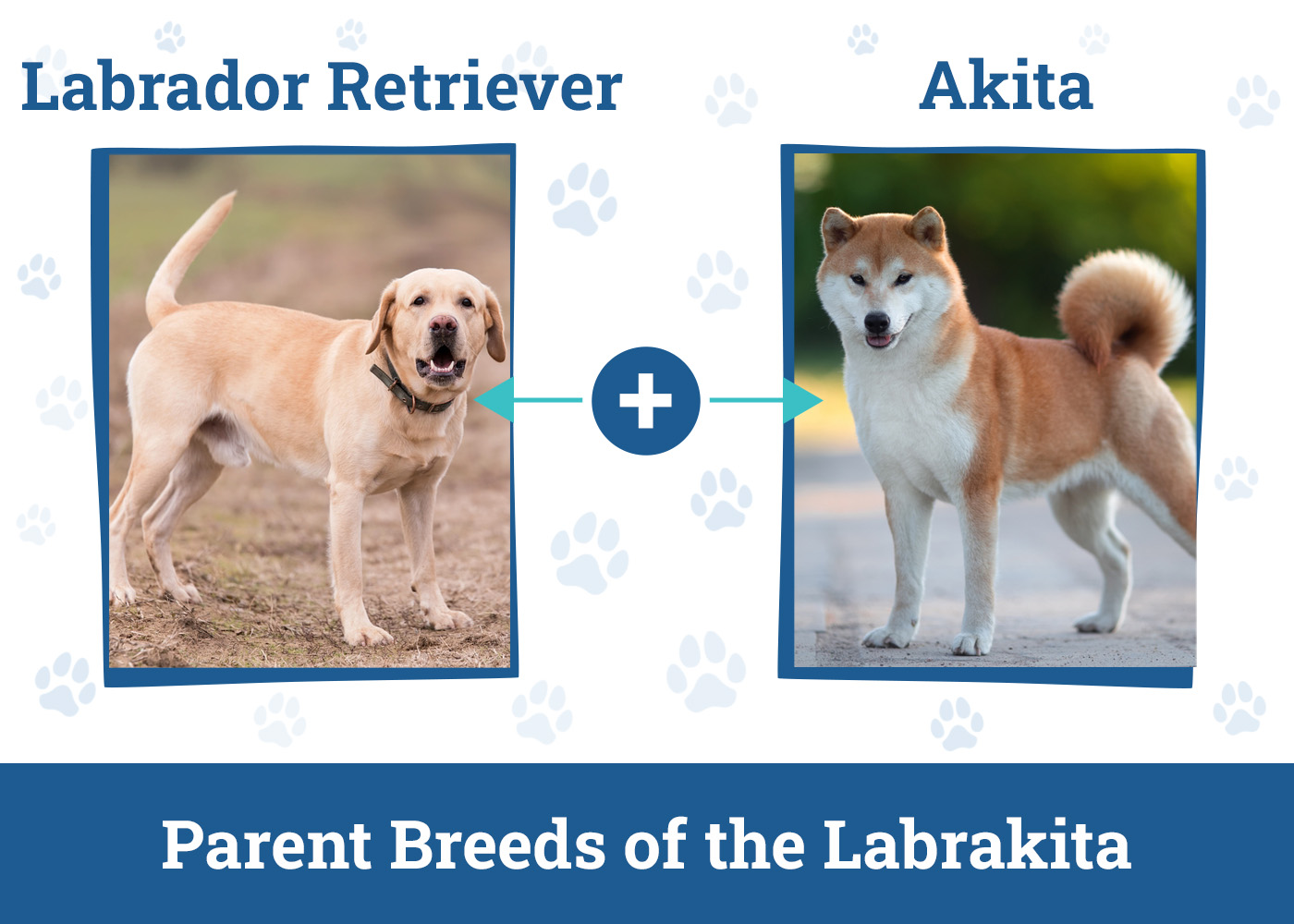
Temperament & Intelligence of the Labrakita
Both Labradors and Akitas are incredibly smart and capable dogs. They are quick to catch on to things and take (relatively) little time to learn something new. Their witty minds also make these amazing dogs great at various activities, including, of course, puzzle games. So, don’t be surprised when a Labrakita pup starts acting like a grown-up: it’s in their blood! But what about the character—what kind of a personality does this mixed breed have?
Loyal guardians: that’s the best way to describe Labrakitas. They are faithful to their owners to the very end and create brick-strong, meaningful bonds. In the right environment, these dogs aren’t afraid to be affectionate and even a bit foolish. Now, Labs are gentle, easy-going dogs. Akitas, in contrast, are more hesitant and standoffish. So, depending on which parent’s temperament the Labrakita adopts, it’ll either be the life of the party or a loner.
Are These Dogs Good for Families?
Yes, Labrakitas can be amazing pets for a big, loving family, but only if they spend enough time with the pup and train it. Primarily, we’re talking about obedience training paired with socialization. Both parent breeds are family-oriented pets that put loyalty above everything else. That’s why they’re often adopted by seniors: this crossbreed is profoundly devoted, active, smart, and happy to acknowledge your leadership.
Singles in the market for an energetic, playful, yet level-tempered fur baby find these pets to be a great choice as well. On the downside, small or even average-size apartments are not the best environment for a Labrakita. Ideally, they should live on a fenced property and have quick access to the great outdoors. Otherwise, they might get a bit anxious and start chewing on things. This mostly comes from Labs; Akitas won’t mind living in a tiny room as long as you’re there.
What About Little Children?
The short answer is no; this mixed breed is not the best choice for families with little kids. Adult children who know how to treat a dog, play with it, and feed it won’t have any trouble with this affectionate, sweet dog. Sadly, the same can’t be said about kiddos. The thing is that Labrakitas aren’t very patient or tolerant and don’t like to be teased, pulled, pushed, or mounted. Therefore, if you have infants or even teenagers in the house, supervision is a must.
By showing the children and the pup how to act around each other and setting up some ground rules, you should be able to “break the ice”. But still, even after proper socialization, you can never leave the pet and the little ones alone. When provoked, a Labrakita can be a bit aggressive, which is NOT what you want the kids to experience. And sometimes, it’s the kids that end up hurting the dog.
Does This Breed Get Along With Other Pets?
By default, Labrakitas are hard-wired not to be very trusting around strangers. That includes people, dogs, cats, and other pets. So, if you adopt an adult dog that’s never been properly socialized, it will be very hard to change its behavior. At the same time, a puppy that’s introduced to new faces every single day will grow into an open-hearted, friendly canine. That’s why it’s vital to put effort into early socialization and training.
With the right approach (and a little bit of luck), a dog that’s naturally standoffish with strangers will happily make new buddies. At the very least, it will become more tolerant of strangers. The Labrakita will probably still try to establish itself as the alpha/leader, but you’ll hear less barking and less aggression. After all, it’s an adventurous, curious, and upbeat dog that loves to play and show off. This is a trait it inherits from the Labrador.

Things to Know When Owning a Labrakita
Food & Diet Requirements
This is a large, energetic, and playful dog. To keep it well-fed, get your hands on premium-quality food that’s rich in protein, omega-3 fats, vitamins, and minerals. Labrakitas will benefit from a healthy dose of carbs as well. But make sure there are no filler ingredients, as they won’t do much good for the pup. Check the list on the back of the can/bag: real animal meat should be among the main ingredients. Some veggies wouldn’t hurt, either.
On average, active Labrakita pets eat 2–4 cups of food per day. To protect them from bloat (a common condition in deep-chested dogs like Labradors that makes the stomach twist), keep the food portions small. Lastly, to get the perfect balance of nutrients, consult with a veterinarian. They’ll help you find the right products and ingredients to fit the age, sex, activity level, and environment of your four-legged family member.
Exercise
Akitas aren’t the biggest fans of workouts and will be happy with 30–60 minutes of exercise or even less. Labradors, in contrast, need up to two hours of activity per day to stay physically and mentally healthy. As for Labrakitas, aim for 60–90 minutes of daily exercise. However, if it’s a pup, we would recommend having 2–3 shorter sessions spread across the day instead of exercising with the dog for 1.5 hours straight.
Walking, hiking, field trials, hunting adventures, and swimming are among the favorite activities for a Labrakita. Since these dogs are always thrilled to do something fun with their owners, it shouldn’t be hard to take them outside for a simple walk around the block. Start there and gradually introduce the fur baby to more challenging exercises. This will help get rid of the built-up energy and get the doggo ready for a good night’s sleep.
Training
The Labrador and Akita crossbreed is an intelligent, independent dog. With that, it can also be a bit standoffish and stubborn. For a first-time owner, that means the pet will readily follow your lead, yet they might be a bit of a challenge to train. This is exactly why it’s important to start obedience training at a young age while the pup is still in development. Also, don’t forget that both Akitas and Labradors were bred as hunters: naturally, they have a strong prey drive.
To keep them focused on the training, practice in the backyard where the dog won’t have any “temptations”. And one more thing: Labrakitas aren’t at all clingy, demanding, or choosey. They do, however, require attention and can develop separation anxiety when left on their own for long. Thus, to turn a Labrakita puppy into an exemplary dog, you’ll have to put in extra hours in training. Think about this in advance before adopting one.
Grooming ✂️
Akitas are notoriously known as heavy shedders. Labradors also have a double coat that needs special care. To keep shedding to a minimum, brush the fur 2–3 times a week with a slicker brush (the same goes for the dog’s teeth). Don’t forget about the nails: trim them once a month to keep the dog comfortable. As for bathing, only do it occasionally (once in two or three months). Labrakitas like to take care of their hygiene, so you won’t have to wash them every single day.
Besides, frequent bathing might damage the coat and the skin. Oh, and don’t forget to clean the ears every other week and check them for signs of infection, wax buildup, and other issues.
Health and Conditions
Labradors are among the healthiest breeds to walk the Earth. Just like Akitas, they’re well-built, capable dogs that can easily handle severe conditions, exposure to weather elements, and various diseases and parasites. That said, both breeds are prone to bloat, dysplasia, and other conditions that are frequently diagnosed in dogs of their size. Here’s a quick look at the most common minor and severe medical issues a Labrakita owner might have to face:
- Obesity
- Ectropion/Entropion
- Various congenital eye defects
- Hyperthyroidism
- Gastric Dilatation-Volvulus
- Dysplasia
- Hereditary Myopathy
- Progressive Retinal Atrophy
- Epilepsy

Male vs Female
The biggest difference between male and female Labrakita dogs is their size. For example, Labrador and Akita boys are 10–20 pounds heavier and 2–2.5 inches taller than the girls. You should expect to see the same proportions in Labrakita pups. On top of that, males are more aggressive toward fellow canines and territorial, while females tend to be more docile, obedient, and happy to follow your lead.
Male Labrakitas also have a stubborn streak that can only be tackled via early socialization. For this reason, they take a bit more effort to potty train. Females are a much better pick in this regard. But since the boys can’t get pregnant, you won’t have to worry about an entire litter when the breeding season comes (which usually kicks in sometime around spring). But every single dog is unique. So, you might get a feisty female or a docile male!
3 Little-Known Facts About the Labrakita
1. The Parent Breed Can Be a Japanese or American Akita
Are you a bit confused about the Akita side of the Labrakita? Can’t figure out whether it should be an American doggo or a Japanese Akita Inu? Well, there are no strict rules when it comes to mating a Lab to an Akita. Do keep in mind, however, that US-bred Akita dogs are larger than their Japanese siblings. More than that, they have different eyes and ears and tend to be more open toward strangers.
So, if you just adopted a Labrakita and it looks much smaller than expected, most likely, it’s a Lab and Akita Inu crossbreed. Make sure to check both parent breeds before you pay for a Labrakita pup. It’s always better to know in advance what kind of a doggo you’ll have on your hands once it grows up instead of going blind.
2. Labrakitas Are Recognized by Most Major Canine Clubs
Since this is a mixed breed, it’s not acknowledged by the AKC, UKC, or other clubs that focus solely on purebred pups. However, that doesn’t mean Labrakitas don’t get any love from other clubs. They are officially recognized by the DRA (Dog Registry of America), DBR (Designer Breed Registry), IDCR (International Designer Canine Registry), and the ACHC (American Canine Hybrid Club). And don’t worry; you won’t have to take the dog to any “exotic” doctors.
While the Labrakita isn’t the most popular breed, a professional veterinarian at a local clinic shouldn’t have any problems examining or treating it.
3. They Are Available in Different Coat Colors
Like most mixed breeds, the Labrador and Akita lovechild comes in a wide range of colors. You can go with the classics (white or black) or choose something a bit more eye-catching like cream or red. If you want the puppy to look more like its Lab parent, you’ll be able to do that with a fawn, brown, or brindle coat. At the same time, a Labrakita with markings will resemble an Akita more. The color of the coat won’t affect the pet’s behavior, health, or needs. So, choose whatever looks good.

Final Thoughts
Labrakitas are sweet, intelligent, and capable dogs. Their protective nature, eagerness to please, and witty minds turn them into canine superstars. And don’t get us started on those cute puppy eyes and perky ears! The Labrador and Akita crossbreed is healthy, has an above-average lifespan, and loves to be around people it trusts. On the downside, it’s not exactly the most social dog on the planet.
While early socialization and extensive training will help, by nature, Labrakita pups are aloof with strangers and aggressive toward other pets. On top of that, while they can live in small apartments for short periods, ideally, they prefer open areas with fresh air and lots of space to explore. Summing up, Labrakitas are a great choice for big, active families with large fenced properties.
If you can’t decide between the world-famous Labradors and the exotic Akita buds, a Labrakita could very well be a match made in Heaven for you. Just make sure to adopt from a reputable breeder or shelter, check the pup’s history, and spend at least 1–2 hours with the doggo to train it, make it feel loved and cherished, and turn it into an open-hearted pet.
See also:
- Akita Shiba Mix: Care Guide, Pictures, Info & Traits
- Labrakita (Akita Lab Mix): Care Guide, Pictures, Info & Traits
